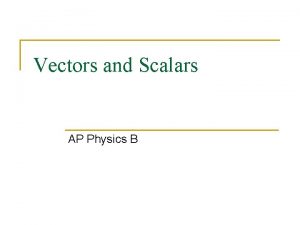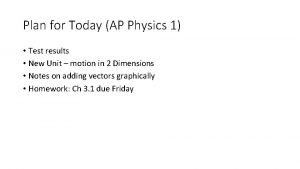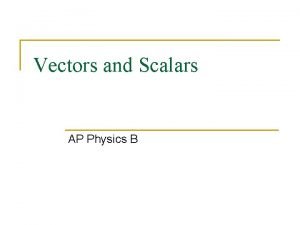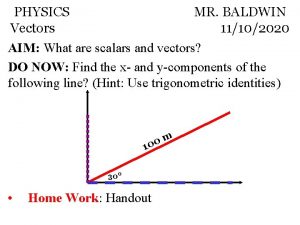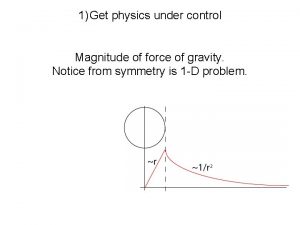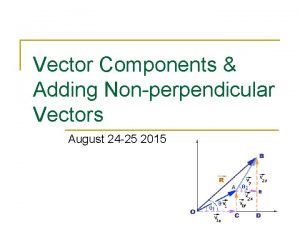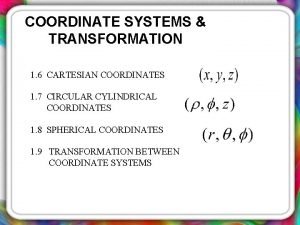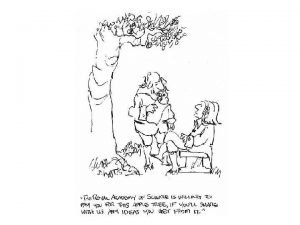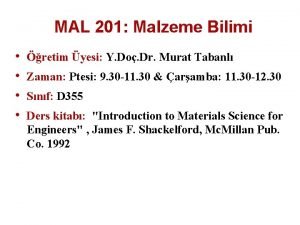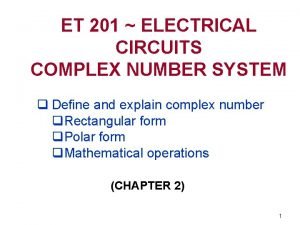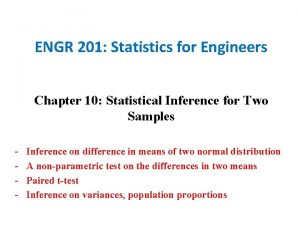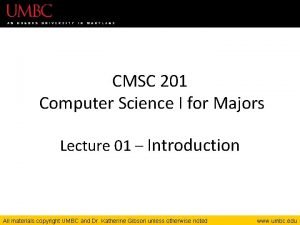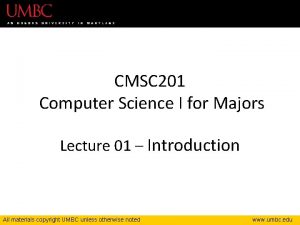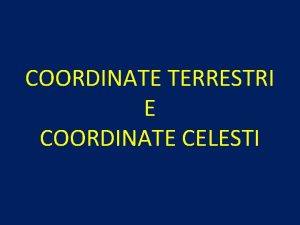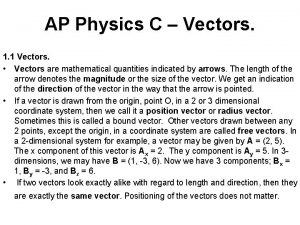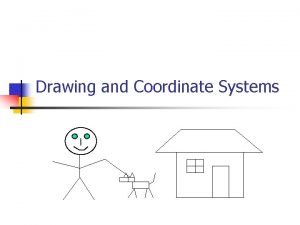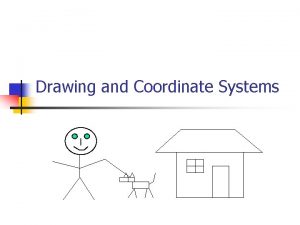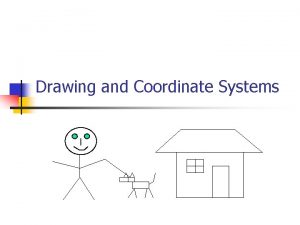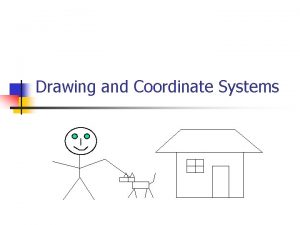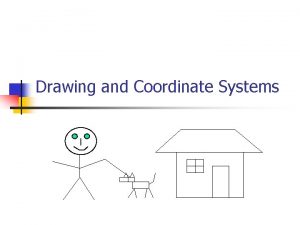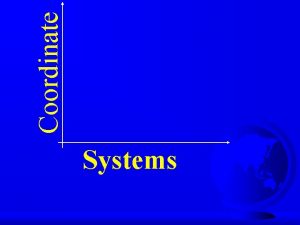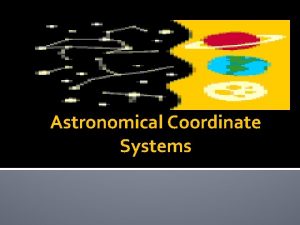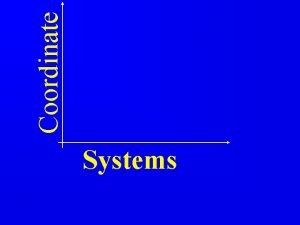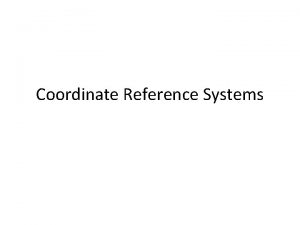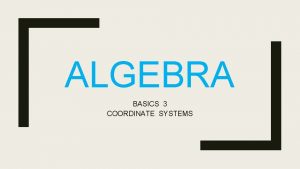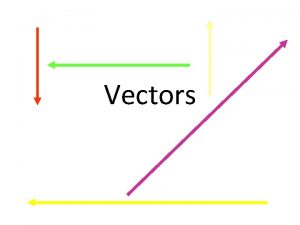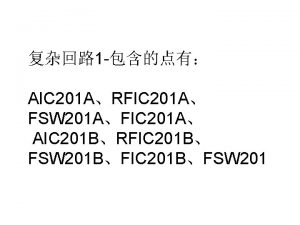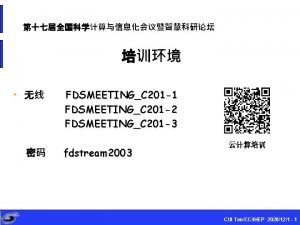Physics 201 2 Vectors Coordinate systems Vectors and




























- Slides: 28

Physics 201 2: Vectors • Coordinate systems • Vectors and scalars • Rules of combination for vectors • Unit vectors • Components and coordinates • Displacement and position vectors • Differentiating vectors • Kinetic equations of motion in vector form • Scalar (=dot) product of vectors

Coordinate Systems • 1. Fix a reference point : • ORIGIN • 2. Define a set of directed lines that intersect at origin: • COORDINATE AXES • 3. Instructions on how to label point with respect origin and axes.

y p b r q a • rectangular cartesian coordinates of point “p” = (a, b) • plane polar coordinates of point “p” = (r, q) x

Measurement of Angles s r in Radians q is measured counterclockwise from + x-axis


Vectors and scalars • Scalar: • has magnitude but no direction • e. g. mass, temperature, time intervals, . . . • Vector: • has magnitude and direction • e. g. velocity, force, displacement, . . . • Displacement vector • line segment between final position and initial position.

Properties of vectors r denoted by : v or magnitude denoted by = v length : v or can always represent a vector by a directed line segment: y x v

• Two vectors are equal if they have • same length • same direction = parallel transport is moving vector without changing length or direction

Addition V 2 tip V 1 tail +

V 1 V 2 V 1 + V 2


Unit vectors Any vector that has magnitude i. e. a = 1 is a unit vector 1

special unit vectors k i j

components of vectors V yj xi V = xi + yj

V yj xi components of vectors

v q x i yj

coordinates of vectors (x, y) V yj V xi V=xi + yj

• 1 -1 correspondence between vectors their coordinates • V = xi + yj =(x, y) and Addition : ( ) b =b i +b j º(b , b ) a +b ={a +b }i+{a +b }jº(a +b , a +b ) a = axi +ayj º ax , ay x x x y y

b a Scalar Product

coordinate form of scalar product

V j V = xi + yj i V· i = x = V Cos (q ) V· j = y = V Sin (q )

Polar form of vectors v = v x i + v y j = v cos q i + v sin q j = v (cos q i + sin q j) º v (cos q, sin q ) now (cos q i + sin q j) = cos 2 q + sin 2 q = 1 Thus vˆ = cos q i + sin q j is a unit vector in the direction of v and v = v vˆ POLAR FORM of the vector v vˆ = v v

Special Vectors (x, y) r ri d rf

differentiating vectors

Vector Kinetic Equations of Motion

Solving Problems Involving Vectors 1. Graphically ! Draw all vectors in pencil ! Arrange them tip to tail ! Draw a vector from the tail of the first vector to the tip of the last one.

! measure the angle the vector makes with the positive x-axis ! measure the length of the vector. ! measure the length of its X component ! measure the length of its Y component

2. Algebraically ! write all vectors in terms of their X and Y components ! The X component of the sum of the vectors is the sum of the X components ! The Y component of the sum of the vectors is the sum of the Y components
 Chain indexing examples
Chain indexing examples Coordinate covalent bond vs coordinate ionic
Coordinate covalent bond vs coordinate ionic A storm system moves 5000 km due east
A storm system moves 5000 km due east Ap physics vectors
Ap physics vectors Ap physics vectors test
Ap physics vectors test Ap physics vectors
Ap physics vectors Physics vectors
Physics vectors Physics vectors
Physics vectors Is 5m a vector or scalar
Is 5m a vector or scalar How to add non perpendicular vectors
How to add non perpendicular vectors Transformation from cartesian to spherical coordinates
Transformation from cartesian to spherical coordinates Rotating coordinate systems
Rotating coordinate systems Modern physics vs classical physics
Modern physics vs classical physics University physics with modern physics fifteenth edition
University physics with modern physics fifteenth edition Ia ideas physics
Ia ideas physics Math 201 bryant and stratton
Math 201 bryant and stratton Decision support systems and intelligent systems
Decision support systems and intelligent systems Big ed mona multimodal text
Big ed mona multimodal text Nf p 40-201
Nf p 40-201 Mcb 201
Mcb 201 Kafes parametresi formülü
Kafes parametresi formülü Toon company
Toon company Fst 201
Fst 201 14-13
14-13 Engr 201
Engr 201 201 principles of software development pdf
201 principles of software development pdf Duke cs 201
Duke cs 201 Cmsc 201 umbc
Cmsc 201 umbc Cmsc 201
Cmsc 201



